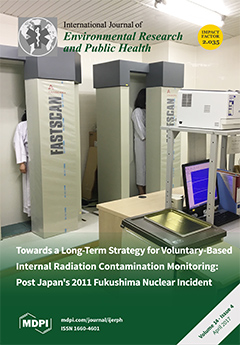Air pollutants are associated with cardiovascular death; however, there is limited evidence of the effects of different pollutants on out-of-hospital cardiac arrests (OHCAs) in Beijing, China. We aimed to investigate the associations of OHCAs with the air pollutants PM
2.5–10 (coarse particulate matter),
[...] Read more.
Air pollutants are associated with cardiovascular death; however, there is limited evidence of the effects of different pollutants on out-of-hospital cardiac arrests (OHCAs) in Beijing, China. We aimed to investigate the associations of OHCAs with the air pollutants PM
2.5–10 (coarse particulate matter), PM
2.5 (particles ≤2.5 μm in aerodynamic diameter), nitrogen dioxide (NO
2), sulfur dioxide (SO
2), carbon monoxide (CO), and ozone (O
3) between 2013 and 2015 using a time-stratified case-crossover study design. We obtained health data from the nationwide emergency medical service database; 4720 OHCA cases of cardiac origin were identified. After adjusting for relative humidity and temperature, the highest odds ratios of OHCA for a 10 μg/m
3 increase in PM
2.5 were observed at Lag Day 1 (1.07; 95% confidence interval (CI): 1.04–1.10), with strong associations with advanced age (aged ≥70 years) (1.09; 95% CI: 1.05–1.13) and stroke history (1.11; 95% CI: 1.06–1.16). PM
2.5–10 and NO
2 also showed significant associations with OHCAs, whereas SO
2, CO, and O
3 had no effects. After simultaneously adjusting for NO
2 and SO
2 in a multi-pollutant model, PM
2.5 remained significant. The effects of PM
2.5 in the single-pollutant models for cases with hypertension, respiratory disorders, diabetes mellitus, and heart disease were higher than those for cases without these complications; however, the differences were not statistically significant. The results support that elevated PM
2.5 exposure contributes to triggering OHCA, especially in those who are advanced in age and have a history of stroke.
Full article





